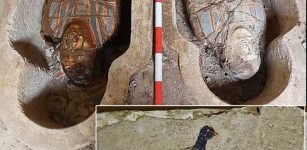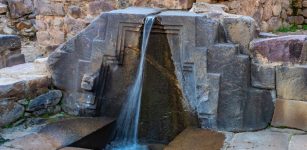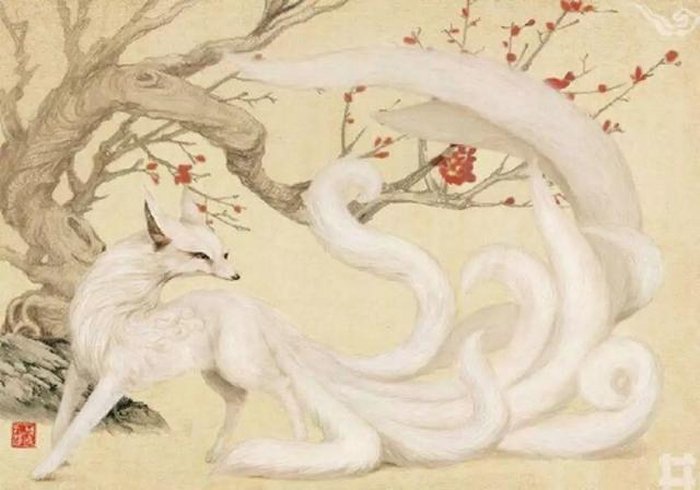Yokai Kitsune: Charming And Cunning Liar With Double Nature In Japanese Folklore
A. Sutherland - AncientPages.com - One of the most important and famous figures in Japanese mythology is Kitsune (‘fox’).
‘Kitsune’ is included in a large group of creatures known as Yokai (yōkai – demons, goblins, spirits, apparitions, leprechauns,) that are feared, admired, and worshiped almost as deities.
These demonic entities are believed to belong to the supernatural world, and they move between their world and the real one. Supernatural forces inhabit virtually every piece of their country, and they have shaped the Japanese culture.
Can We Consider Kitsune As Good Beings?
It seems we can, but we have to be very cautious because kitsune, like many other Yokai, has a dual nature.
Kitsune is a charming and cunning liar that can demonstrate the benevolent nature as a guardian or a devoted companion, and another time tends to misbehave.
But we must not forget that kitsune can easily show the other side of its nature, which is elusive and ruthless. Kitsune likes mischief, pranks and can become a dangerous shapeshifter or soul-possessed enemy demon.
Ancient Japanese literature, historical sources, and local folk tales indicate that this creature exists and represents two opposing aspects of the world, the good and the evil.
You can admire and worship the kitsune, but please remember that the kitsune symbolizes the laws of nature. Therefore, for your own safety, you must also keep a certain distance to it and fear it, too.
Kitsune And The Deity Inari
In the beliefs of the Japanese people, some of the most prominent kami are Amaterasu, Izanagi, Izanami, Susanoo, and Inari, the Shinto deity.
Inari in the Japanese beliefs is the kami (a spirit with holy powers) of the rice fields, and it existed since at least the Nara period (710–784 AD) and had many other responsibilities as a deity of fertility, farming, fishing, cultivation, productivity, prostitution, and the martial art.
A connection between Inari and kitsune has started about the 11th century. This significant cult has about forty thousand shrines scattered across Japan, all decorated with images and statues of these holy foxes guard the entrances to the deity’s temples.
As divine messengers of Inari, they act as a bridge between the human and celestial worlds.
Many early Japanese tales of kitsune can be traced back to China, where the creature was also known for its shape-shifting talents, most notoriously taking on the guise of beautiful, seductive women. Still, they could also suddenly emerge as an older man.
Divinity And Colors of Foxes
In folk beliefs, most kitsune can be red, black, gold, and silver (or white). But not only white (silver) Inari foxes had an aspect of divinity.
Kinko and Ginko (gold and silver kitsune) are two in one as a unity, and incarnation of Yin-Yang dualism. While Kinko is the manifestation of Yin representing the Sun, Ginko, on the other hand, is the manifestation of Yang representing the Moon.
On their backs, they carried the Buddhist goddess Dakini (sacred female spirit in Hinduism and Vajrayana Buddhism).
A white fox – usually understood as a harbinger of death was also Dakini’s private messenger.
Kitsune Likes To Feed On Life Energy Of People
According to mythology, Kitsune (known by different regional names) is a multitalented spirit mentioned in the earliest Japanese texts.
 Statue of kitsune at Inari Temple in Tōdaiji in Nara, Japan. Source
Statue of kitsune at Inari Temple in Tōdaiji in Nara, Japan. Source
Mythological sources confirm two types of kitsune: the ‘zenkos,’ also known as ‘Inari Foxes,’ who are the deity’s messengers; the second group represents ‘yako’ (wild foxes) that can be bad and even evil, and associated with chaos. They are said to feed on the life energy of people or their spirits.
They had transformation ability and most often took the form of a beautiful young woman or monk. However, the length of the transformation was dependent on the age of kitsune. Foxes that were at least five hundred years old could last in any form for a very long time.
Young, inexperienced kitsune could not wholly transform, and their tails were often sticking out from under their clothes.
See also:
Nurikabe: Trickster That Manifests Itself As Invisible, Impassable Wall In Japanese Old Beliefs
Demon Oni: Cruel Harbinger Of Disease And Misfortune In Japanese Folklore
In the ‘Nihonshoki’ - the first official source of history of Japan, and even an essential reference for Japanese myth – the creatures appear as omens, either good or bad.
It sometimes happened that their malice was so painful that as a consequence, the creatures led the unfortunate person to mental illness and even death.
In Japanese mythology, the fox could have another tail every hundred years, and those who have lived for a thousand years had as many as nine tails and possessed the ability to see as far as possible.
The more tails a kitsune has, the older, wiser, and more powerful it is.
Kitsune And Good Harvest
An ancient belief says that farms that always were successful with a good harvest must have any unique association with foxes, which in some way, could contribute to the people’s wealth. These people were believed to be the so-called ‘kitsune-mochi families’ (the owners of kitsune. In consequence, they were protected by yokai spirits, who cared for the family’s good harvest and wealth of the household and warded off evil spirits.
Because of their potential power and influence, some people make sacrifices to kitsune as to a deity by offering fried soybean curd at Inari shrines, a food, which is a favorite of foxes.
Written by – A. Sutherland - AncientPages.com Senior Staff Writer
Copyright © AncientPages.com All rights reserved. This material may not be published, broadcast, rewritten or redistributed in whole or part without the express written permission of AncientPages.com
More From Ancient Pages
-
 12 Masonic Symbols Explained
Ancient Symbols | Jul 2, 2018
12 Masonic Symbols Explained
Ancient Symbols | Jul 2, 2018 -
 Intriguing Ptolemaic And Roman Treasures Unearthed In Al Bahnasa, Egypt
Archaeology | Jan 10, 2024
Intriguing Ptolemaic And Roman Treasures Unearthed In Al Bahnasa, Egypt
Archaeology | Jan 10, 2024 -
 Mystery Of Famous Viking Ruler Rollo: DNA Experts Seek The Truth About His Identity
Featured Stories | Mar 16, 2016
Mystery Of Famous Viking Ruler Rollo: DNA Experts Seek The Truth About His Identity
Featured Stories | Mar 16, 2016 -
 What Were Victorian Bathing Machines?
Ancient History Facts | Jun 9, 2018
What Were Victorian Bathing Machines?
Ancient History Facts | Jun 9, 2018 -
 Nomadic People’s 1,500-Year-Old Imperial Worship Unearthed In Hohhot, Inner Mongolia
Archaeology | Nov 18, 2020
Nomadic People’s 1,500-Year-Old Imperial Worship Unearthed In Hohhot, Inner Mongolia
Archaeology | Nov 18, 2020 -
 Gigantic Ancient Palace Unearthed In Mexico’s Valley Of Oaxaca
Archaeology | Mar 29, 2017
Gigantic Ancient Palace Unearthed In Mexico’s Valley Of Oaxaca
Archaeology | Mar 29, 2017 -
 5,000-Year-Old Perga City And Kommagene Civilization: Most Of Treasures Are Still Underground
Archaeology | Dec 30, 2017
5,000-Year-Old Perga City And Kommagene Civilization: Most Of Treasures Are Still Underground
Archaeology | Dec 30, 2017 -
 Incamisana Water Temple At Ollantaytambo, Peru: Marvelous Engineering Masterpiece Of Inca
Ancient Technology | Jul 19, 2019
Incamisana Water Temple At Ollantaytambo, Peru: Marvelous Engineering Masterpiece Of Inca
Ancient Technology | Jul 19, 2019 -
 Strange Encounter With A Dead Medieval Army In Normandy – Or Were They Visitors From A Parallel World?
Featured Stories | Nov 5, 2017
Strange Encounter With A Dead Medieval Army In Normandy – Or Were They Visitors From A Parallel World?
Featured Stories | Nov 5, 2017 -
 Four Magical Treasures Of Tuatha De Danann
Celtic Mythology | Jan 23, 2023
Four Magical Treasures Of Tuatha De Danann
Celtic Mythology | Jan 23, 2023 -
 Angerona – Goddess Of Silence During Cosmic Crises And Protector Of Ancient Rome
Featured Stories | Feb 15, 2019
Angerona – Goddess Of Silence During Cosmic Crises And Protector Of Ancient Rome
Featured Stories | Feb 15, 2019 -
 Steamship SS Mesaba Sent Warning To RMS Titanic In 1912 – Her Wreck is Now Identified
Archaeology | Sep 27, 2022
Steamship SS Mesaba Sent Warning To RMS Titanic In 1912 – Her Wreck is Now Identified
Archaeology | Sep 27, 2022 -
 Incredible Cave With Secret ‘Door’ Discovered In The American West – Fascinating Underground Mystery
Featured Stories | Nov 19, 2024
Incredible Cave With Secret ‘Door’ Discovered In The American West – Fascinating Underground Mystery
Featured Stories | Nov 19, 2024 -
 Ancient Medical Machine Ahead Of Its Time Hidden In Emperor’s Temple – Secret Science Knowledge Examined
Featured Stories | Apr 20, 2018
Ancient Medical Machine Ahead Of Its Time Hidden In Emperor’s Temple – Secret Science Knowledge Examined
Featured Stories | Apr 20, 2018 -
 Mayong – Mysterious Ancient Land Of Black Magic In India
Featured Stories | Mar 7, 2019
Mayong – Mysterious Ancient Land Of Black Magic In India
Featured Stories | Mar 7, 2019 -
 Amazing Restoration Of Ancient Roman Vineyard Buried Underneath The Ash Of Mount Vesuvius For 2,000 Years
Archaeology | Nov 27, 2020
Amazing Restoration Of Ancient Roman Vineyard Buried Underneath The Ash Of Mount Vesuvius For 2,000 Years
Archaeology | Nov 27, 2020 -
 Illapa: Powerful Master Of Clouds, Rain And Hail – Worshipped By Inca People
Featured Stories | Jul 7, 2016
Illapa: Powerful Master Of Clouds, Rain And Hail – Worshipped By Inca People
Featured Stories | Jul 7, 2016 -
 Early Homo Sapiens From Southeast Asia Could Adapt To A Rainforest Environment
Archaeology | Oct 17, 2021
Early Homo Sapiens From Southeast Asia Could Adapt To A Rainforest Environment
Archaeology | Oct 17, 2021 -
 DNA Of Nine 13th Century Crusaders Provides A Glimpse Into Soldiers’ Life And Death
Archaeology | Apr 22, 2019
DNA Of Nine 13th Century Crusaders Provides A Glimpse Into Soldiers’ Life And Death
Archaeology | Apr 22, 2019 -
 On This Day In History: The Battle Of Actium – Birth Of The Roman Empire – Sep 2, 31 BC
News | Sep 2, 2015
On This Day In History: The Battle Of Actium – Birth Of The Roman Empire – Sep 2, 31 BC
News | Sep 2, 2015


